
The deserts of the Americas and Africa: teeming with life!
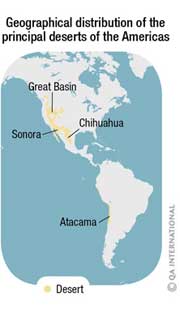
Fauna and flora of the deserts of the Americas
The Great Basin, the Sonora and the Chihuahua are among the principal arid zones of North America. The Atacama Desert in South America is the driest place in the world, with an average annual rainfall of 1.1 mm. The desert plants of the Americas, which consist of cacti, agaves and thorny shrubs, along with the small animals that live on this hostile landscpape, are perfectly adapted to living with the scarcity of water.

Cacti
Most of the 2,000 species of cacti are native to the hot and arid regions of the Americas. Coming in a multitude of forms (racket, ball, cylinder, etc.), these succulent spiny plants often flower during the night, as they are pollinated by nocturnal animals such as bats. The saguaro is a giant cactus found in the Sonoran desert of the southern United States and northern Mexico. It can stand up to 15 m tall and store several hundred liters of water in its trunk and branches.
The black widow
The black widow (Latrodectus hesperus) is an extremely venomous spider that lives in the desert and other hot regions of the world. Although it is much larger than the male, the female measures no more than 3.5 cm in length. A carnivore, the black widow immoblizes its prey (mainly insects) with its powerful venom. Its bite, however, is rarely fatal to humans. After mating, the female may devour the male, which is how the spider got its name.
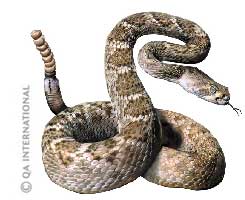
The western diamondback rattlesnake
The rattlesnake is one of about 30 species of venomous snakes found in the Americas. The western diamondback rattlesnake, which lives mainly in the arid regions of the American Southwest, is one of the biggest and most formidable venomous snakes in all the Americas. To intimidate its predators, including the kingsnake, it rattles the scales on its tail to produce its characteristic sound. In the United States, rattlesnakes are responsible for the majority of deaths attributed to reptiles. In spite of this, they only attack humans if they are provoked.

The greater roadrunner
Now famous thanks to a cartoon, the greater roadrunner is an omnivore the size of a small hen. With its head tilted forward, it runs more than 30 km/h across the American desert scrubland, seeming to barely touch the ground. In the coolness of the early morning, the roadrunner likes to expose its back to the sun with its wings spread to absorb the sun’s rays.
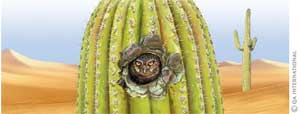
The elf owl
The elf owl is the smallest owl in the world. It grows to a height of no more than 15 cm. Active at night, this bird of the southern United States and northern Mexico searches tirelessly for insects to eat. When day arrives, the elf owl settles into a hole hollowed out by a woodpecker in a large saguaro cactus.
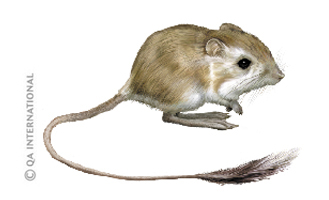
The desert kangaroo rat
A champion at economizing on water, the kangaroo rat lives in the sand dunes of the southwestern North America. This small nocturnal mammal does not drink. It eats dry grain, leaves and stalks, which provide it with all the water it needs. The kangaroo rat does not perspire. It produces droppings that are as hard as small pebbles, which it rechews in order to get all the moisture it can out of them.
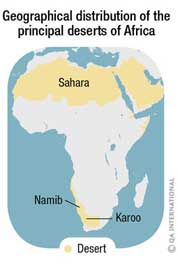
Fauna and flora of the deserts of Africa
The Sahara and the Namib are among the principal deserts of Africa. The ever-expanding Sahara is the largest hot desert in the world: it spreads over nearly 10 countries and covers an area 15 times the size of France. Despite their extreme aridity, the African deserts present an astonishing diversity of plants. The Karoo, a barren region in South Africa, is home to almost one-third of all the species of succulent plants on the planet. Among the animals that populate the African deserts are fennec foxes, numerous lizards, scorpions and, of course, dromedaries, which have been domesticated by humans for more than 4,000 years.
A living fossil
Welwitschia mirabilis is a plant found in the coastal desert of Namibia. Difficult to classify, it does not resemble any other plant and is in fact a relic of plants that are now extinct.Welwitschia mirabilis can live 2,000 years and may be up to 4 m in diameter! It is highly resistant to drought, thanks to its large leaves that can absorb dew water.
A carpet of flowers in the desert
Carpets of flowers with a very short life span appear from time to time in Namaqualand, in South Africa. These plants, of which more than 3,000 species are known, are ephemerophytes. They appear and then die quickly, within one to three days, having just enough time to spread their seeds. The seeds go into a dormant period until the next rains come, sometimes waiting years before having their turn to germinate.
The desert locust
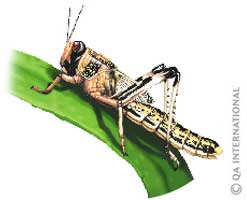
The desert locust is usually found in the southern Sahara and the Middle East. When their number greatly increases, these normally solitary insects gather in giant swarms of several million individuals. The black clouds of locusts travel thousands of kilometers and destroy everything in their path, consuming hundreds of kilograms of vegetation each day.
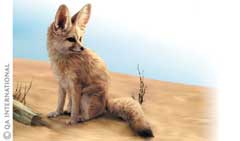
The fennec fox
The fennec is the smallest of the foxes. Its long, wide ears serve as a highly original air conditioning system, helping it to evacuate excess heat from its body. It also allows the fox to detect the slightest sound. In the Sahara, the fennec leaves its den at night to hunt for mice, birds and insects to eat, which also provide it with all the water it needs.
The namib desert dune lizard

Unlike mammals, reptiles have no regulatory system for maintaining their body temperature. To prevent its body temperature from climbing too high, the Namib Desert dune lizard adopts an unusual stance. It lifts its feet, two at a time, to avoid absorbing the blazing heat of the ground. This makes it look like it is dancing on the sand dunes.
The African spiny-tailed lizard
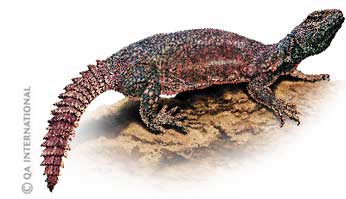
The African spiny-tailed lizard is a solitary creature that lives in the Sahara. It uses its tough, spiky tail to defend itself. This reptile spends its days in its burrow hollowed out under a flat rock or pile of stones. It can easily withstand thirst and a shortage of food. Under the skin on its back is a fat reserve that allows it to fast for almost a year! The spiny-tailed lizard does not drink. All the water it needs comes from the plants that it eats.
Also see:
In the Visual Dictionary:
- "Earth" section
- "vegetable kingdom" section
- "animal kingdom" section
In the encyclopedic capsules:
- Deserts: where Mother Nature is queen
- Sunburns, actual burns inflicted to the skin
- The fauna and flora of polar regions: Arctic
- The fauna and flora of polar regions: Antarctic
- The spider, a web master
- Marsupials
In the ikonet games:
- Put it in its place!: deserts, land pollution, examples of reptiles




